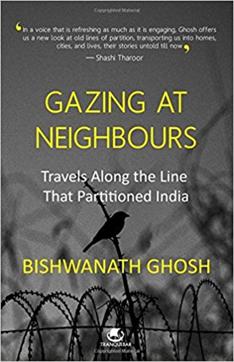A travelogue along the lines of history
These stories of Partition are real and are perhaps the last remaining first-hand narratives from a disappearing generation

Boundaries, they are necessary, some would say. Others would disagree. They define. They limit. They stand like check posts to the outside world, like windows with iron grills, holding all its inhabitants prisoners inside.
This sentiment is conveyed in Gazing at Neighbours, Travels Along the Line That Partitioned India. Author Bishwanath Ghosh marches along the Radcliffe Line on the country’s eastern and western borders; from the fertile lands of Punjab toiling under the harsh sun shared with Pakistan, to the verdant shades of Bengal merging into Bangladesh.
In theory, this is the ideal non-fiction: it’s a travelogue along the lines of history. These stories of Partition are real and they are perhaps the last remaining first-hand narratives from a disappearing generation. For this reason alone, Ghosh’s book should be the perfect read.
However, despite journalistic citations, the book doesn’t really remind the reader about the tragedy of an arbitrary map drawn by an Englishman in haste. Sunsets over rivers and glimpses of the other Punjab from a terrace should have been a poetic, even a humbling experience. But the moments are lost, like the confused identities of those who survived Partition and buried their memories like a totem invisible to the contemporary world. Stories of families divided by an invisible boundary should have been the final blow, but here, they have the impact of a feather gliding into the distance.
Sample this excerpt:
The air was laden with citrusy fragrance. Labourers carrying transparent sacks on their head hurried down the steps of the ghat and practiced gaits: they were transporting some kind of lime from a parked truck to a country boat that flew the Bangladeshi flag. Once the boat reached its capacity, the wiry boatman got his oars working and headed for the opposite bank, making way for another boat, on which the labourers now dumped their sacks. Boats came and boats left.

There are adequate precedents to learn from when it comes to mapping out boundaries and their relevance. Amitav Ghosh’s Shadow Lines follows the coloured perspectives and wavering histories through its characters eyes. The Boy in Striped Pyjamas exemplifies the meaningless of boundaries as a mere coincidence of fate. That story is not about countries, but it portrays its meaning through an untarnished bond between two children – a Jewish child at a concentration camp and a Nazi officer’s son – who haven’t been corrupted by the ideologies of their time. No art has perhaps reflected the world’s cruelty with such a haunting depiction of a friendship existing in shards between barbed wires despite devastating consequences.
Ghosh’s story has the vision to make it great. It has eccentric Indian caricatures, like the Khasi man who built a bamboo tower for a panorama of Bangladesh. The author also provides an empathetic look at the lives of paramilitary troops on the borders. Still, the most captivating portion of Gazing at Neighbours is the section on Meghalaya, where the emerald mountains clash with shadowy clouds and rains.
Despite these elements and good intentions, Gazing at Neighbours doesn’t do justice to a country that was borne out of a cataclysmic freedom struggle and still kneels under Partition’s weight.






